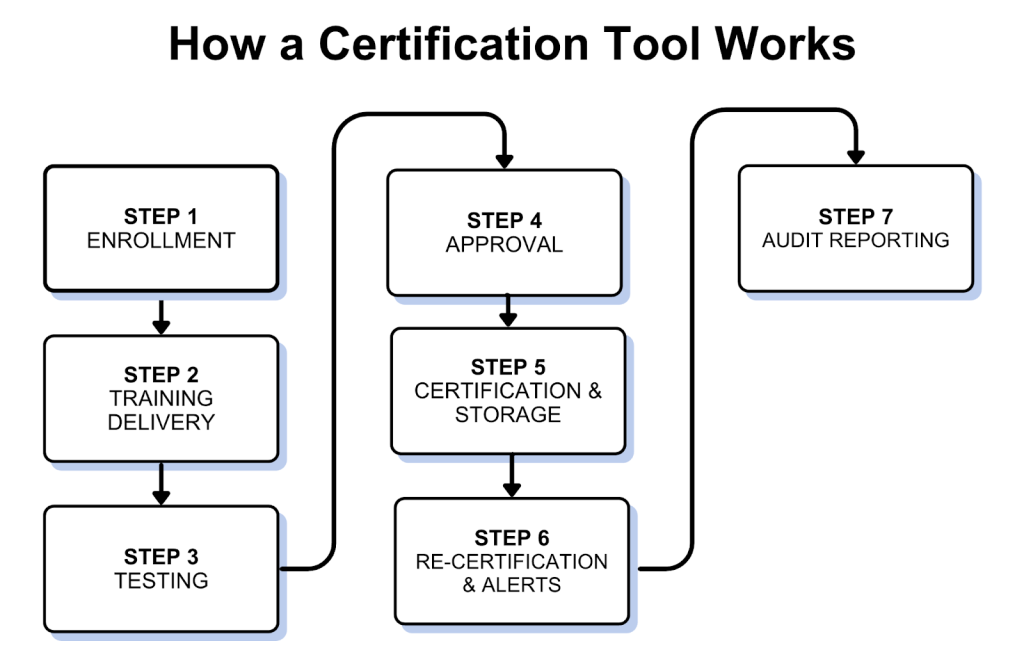
Criminal histories, biometrics, and investigative intelligence are among the most sensitive data law enforcement handles. The secrecy of this information is not only a matter of technology but also of people. That is where CJIS certification comes in.
Complying with the CJIS requirements is always challenging. Agencies are subject to strict audits and constant policy changes, and risk losing access to criminal justice data unless their operators are duly certified. The FBI CJIS Security Policy states that anyone with access to the criminal justice systems should undergo training, testing, and certification.
Failure to meet these standards may lead to compliance failures, failed audits, or even the suspension of system access by the agencies. This paper defines a CJIS certification tool, its significance, and how digital certification systems are revolutionizing compliance management, removing manual spreadsheets and maintaining agencies’ audit readiness throughout the year.
What is CJIS Certification (and Why is it Crucial?)
The Bureau’s biggest section is the Criminal Justice Information Services (CJIS) Division, which serves law enforcement throughout the country. It secures sensitive information like criminal records, biometrics, and investigative intelligence. Access to this information is controlled due to its sensitivity to people’s safety.
According to the FBI CJIS Security Policy (v5.9.1), every individual with access to or operating in support of CJIS systems must complete security awareness training and meet personnel security requirements on data handling and compliance. Certification ensures only qualified personnel can access CJIS systems, reducing the risk of breaches or leaks.
Training is not one-time. Operators are usually required to recertify periodically. Agencies that allow certifications to expire may be subjected to audit results and fines or even be denied CJIS access. Agency coordinators may find it challenging to coordinate this process for dozens or hundreds of staff at various locations.
In brief, CJIS certification tools secure sensitive data, agencies meet the standards of the FBI, and law enforcement leaders are confident that their staff is working responsibly.
Pain Points of Manual Certification
Although CJIS certification is needed to ensure the safety and adherence of sensitive data, many agencies continue to fail to process it properly since they rely on spreadsheets, file folders, or sticky notes to track operator certifications. While this may have worked, today’s compliance standards demand greater accuracy and reliability.
Manual processes pose significant problems:
- Deadlines are not reliable for tracking
Coordinators must remember dozens of expiration dates. Even a single missed security re-certification can trigger compliance concerns.
- Preparation of the audit is tiresome
Months of certification records are frequently needed in the FBI or state audit process. Searching in paper documents is time-consuming and risky.
- No centralized visibility
Leaders do not easily notice who is compliant, overdue, and incomplete in training.
- Human error is common
Typos, lost files, or missed dates can risk an entire agency’s compliance posture.
- Training inefficiencies
Without a digital CJIS training platform, agencies must manually schedule courses, exams, and reporting.
Take the following case: A medium-sized agency with 250 operators uses spreadsheets to track certification. Upon the arrival of an audit, the coordinator will have to gather documents in various storage rooms, email inboxes, and paper binders.
By so doing, they find out that 12 operators are not certified. This not only leads to stress but may also lead to penalties or limitations to CJIS access by the agency.
The takeaway is clear: manual certification management leaves too much room for error.
Simplify certification tracking with PsPortals. By automating deadlines and record-keeping, your team can stay compliant effortlessly.
Benefits of Using Certification Tools

A modern certification tool eliminates these risks by centralizing and automating the process. Rather than working with paper files, coordinators can have a safe, convenient system that stores all the information in a single location. Practical benefits include:
- Automated notifications.
The system gives coordinators and operators ample time in advance of re-certification dates.
- Single source of truth.
All training history, certificates, and approval history are in a single platform.
- Streamlined approvals.
The tool simplifies agency operator approval, ensuring managers can quickly authorize or deny access.
- Combined training.
Many systems feature a built-in CJIS training platform, so operators can complete lessons and exams without leaving the tool.
- Audit-ready reporting.
The coordinators can create compliance reports that meet FBI requirements with a few clicks.
- Scalability.
The system will also adapt to the situation, whether one has to manage 25 or 2,500 operators without causing bottlenecks. Tools can reduce the administrative load borne by the coordinators, enabling them to work on more valuable activities, including better training or internal compliance checks.
Hint: Agencies that implement a certification tool typically experience a decrease in time incurred in dealing with compliance paperwork. Indicatively, LIFT Training states that certification management systems automate reminders, centralize records, and ease audits, saving staff time and easing the burden of manual tracking.
Simplify Compliance with PsPortals
Workflow: How a Certification Tool Works

Let’s walk through the specifics of how a typical CJIS certification tool functions from start to finish:
Step 1: Enrollment
- Coordinators introduce operators to the system.
- All the operators are given training modules depending on their roles.
Step 2: Training Delivery
- Operators access materials through an integrated CJIS training platform.
- Online courses, videos, policy documents, and practice quizzes may be included as content.
Step 3: Testing
- Operators take exams using embedded law enforcement exam software.
- The recording and storage of results is automated and minimizes human error.
Step 4: Approval
- After passing, operators are routed through agency operator approval workflows.
- Supervisors are given digital notifications to check and verify.
Step 5: Certification & Storage
- The certificates are automatically issued and stored in a safe repository.
- When the need arises, coordinators can download or print copies.
Step 6: Re-Certification and Alerts.
- The system tracks timelines for operator recertification.
- Coordinators and operators are reminded automatically months before expiration.
Step 7: Audit Reporting
- Generate single-click reports that give coordinators a full, agency-wide view of compliance status.
- Reports are automatically formatted to meet FBI CJIS audit requirements.
Callout: A good tool monitors certifications and is proactive in preventing lapses by providing built-in reminders and reporting dashboards.
Must-Have Features in Modern CJIS Certification Tools
Not every solution is equal. The agencies that assess certification platforms must seek the following key features:
Security & Compliance
- Complete compliance with FBI CJIS Security Policy (v5.9.1).
- Sensitive data role-based permissions.
- Stored and transmitted records must be securely encrypted.
Certification Management
- Automatic tracking of expiration dates and security re-certification cycles.
- Adjustable notification options.
- Easy digital workflows for agency operator approval.
Training & Testing Integration.
- A seamless CJIS training platform was built into the system.
- Embedded law enforcement exam software with secure proctoring options.
- Trainer and coordinators’ interactive dashboards.
Reporting & Audit Prep
- Real-time audit compliance reports.
- Record of all training and testing activities to trace.
- Export options to provide to state or FBI auditors.
Flexibility & Integrations
- API links to HR, payroll, or LMS.
- Field operator mobile-friendly design.
- Scalability to provide multi-agency environments.
FAQ: Does the adoption of a certification tool mean staff retraining?
Not necessarily. The majority of platforms have user-friendly dashboards. First orientation will require a couple of hours, but the saved time later will be considerable.
Staying Audit-Ready
Audit preparation is among the largest stress-inducers among coordinators. A CJIS certification tool makes audit readiness a continuous process rather than a last-minute scramble.
Key advantages include:
- Up-to-date dashboards. Managers may see operator status by role, department, or certification date at any time.
- Digital audit trails. All actions, such as training done, exams passed, and permission granted, are registered.
- Proactive alerts. The system minimizes the chances of expired certifications since the staff is reminded in time.
- Standardized reporting. Reports are formatted automatically to the requirements of the FBI or state level, without the need to guess.
Pro Tip: Use the tool for quarterly mock audits. This instills confidence in the staff and helps point out time gaps.
FAQ: Why are mock audits necessary?
Periodic mock audits assist agencies in detecting compliance problems in the initial stages, simplify reporting, and keep personnel ready to be inspected by official auditors.
Stay Audit Ready With PsPortals
Real-World Example
In a case study from the Thales Group, 2020, a County Sheriff’s Office in a highly populated area faced a new FBI requirement: all law enforcement agencies transferring data between physical locations, even internally, must encrypt it while in transit.
The agency had previously assumed that its VPN was adequate, but the requirement made it clear that encryption is still required in private networks. They have almost 10,000 employees who deal with sensitive information daily.
The data they work with includes criminal records and information about inmates; therefore, compliance was crucial before their next audit.
The case study indicated that through the application of a high-assurance solution of data-in-transit encryption and a CJIS certification tool, the agency could:
- Ensure that sensitive information, accessible to authorized personnel, is transferred securely.
- Enforce adequate operator re-certification processes to ensure that staff are in line with the CJIS standards.
- Automate agency operator approval, enabling the supervisor to approve or confirm personnel access quickly.
This solution allowed the Sheriff’s Office to address the CJIS compliance standards, share essential information between facilities, and maintain operational efficiency.
Compliance “Must-Haves” Checklist
Here’s a quick reference for coordinators selecting or reviewing their tools:
- Safe storage aligned with FBI CJIS policy
- One-click compliance reports
- Certification due date alerts are automated
- Operator records are centralized
- Integrated training and law enforcement software for examination
- Digital agency operator approval workflows
- Real-time dashboards
- Large agency scalability
Final Thoughts

Due to increasing regulatory requirements, manual certification processes are no longer viable. A CJIS certification tool is automated, transparent, and accountable, and it assists agencies in maintaining operators’ certification and keeping systems safe. These platforms make certification management a proactive process and include built-in training, automatic notifications, simplified approvals, and real-time reporting.
To coordinators, technical managers, and trainers, a digital solution will save time on paperwork so they can concentrate on mission-critical issues. Most importantly, it keeps the operators ready to be recertified in security matters, so your agency is always safe, efficient, and audit-ready.